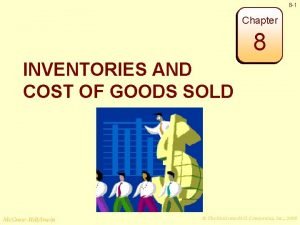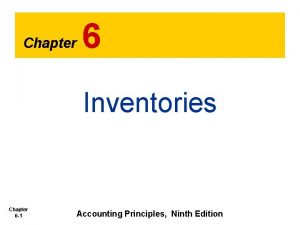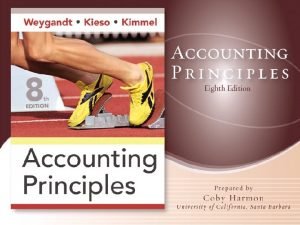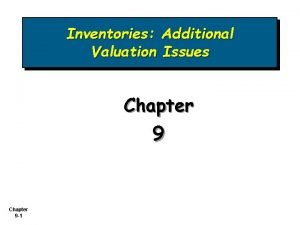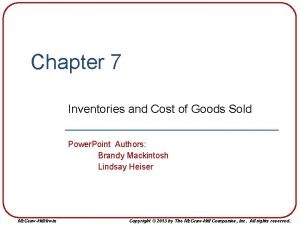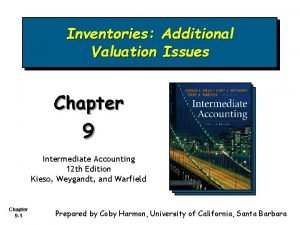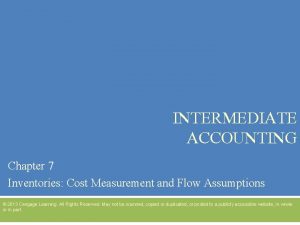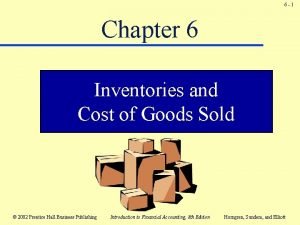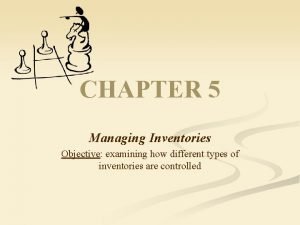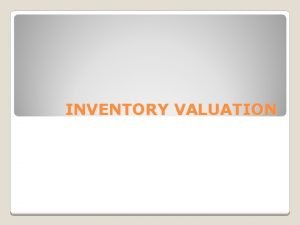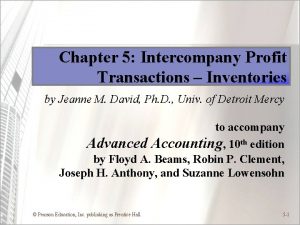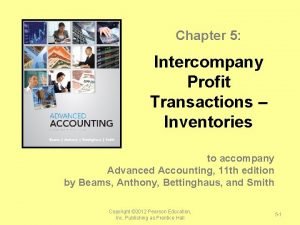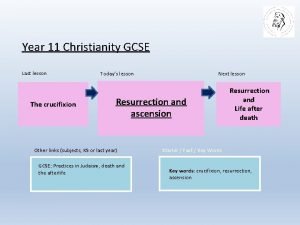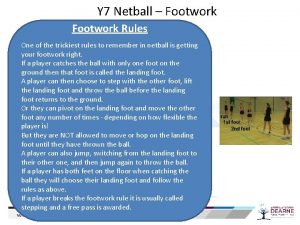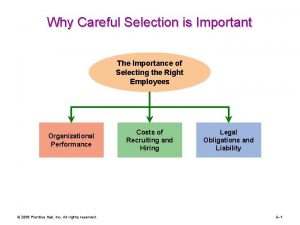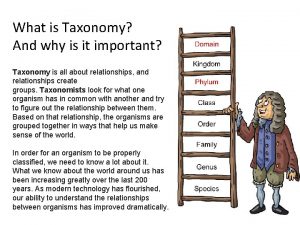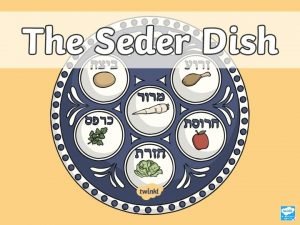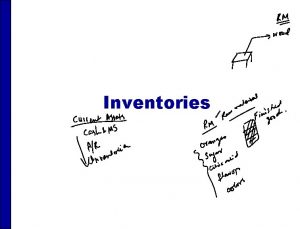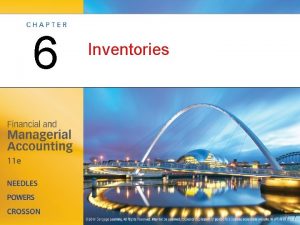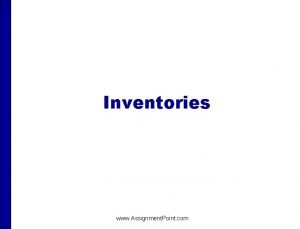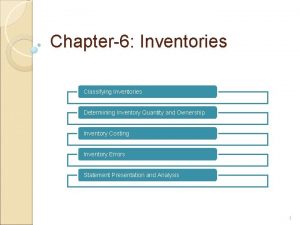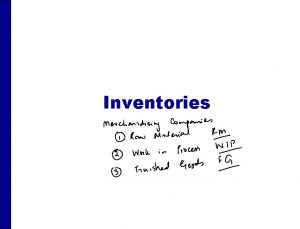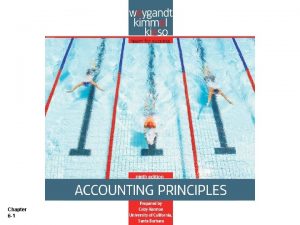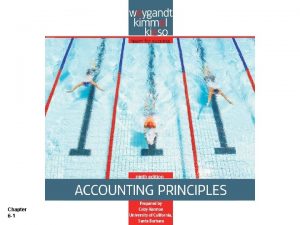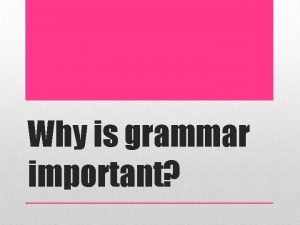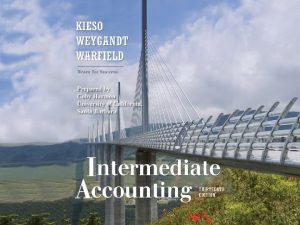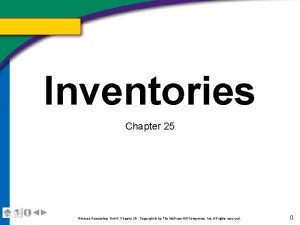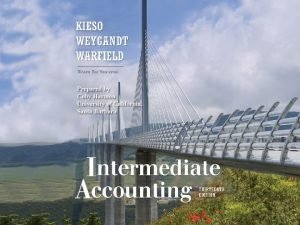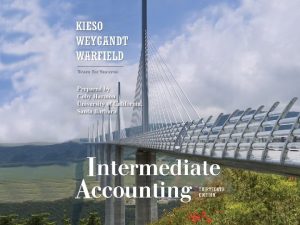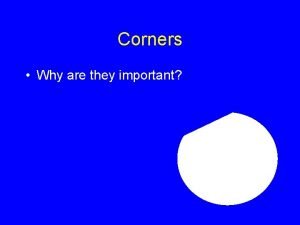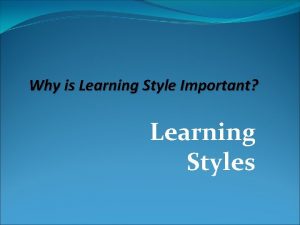5 Inventories Why inventories are so important Chapter



































- Slides: 35

5 Inventories

Why inventories are so important? Chapter 5 Mugan-Akman 2012 2

Composition of Inventories 1. taking a physical count of inventories 2. determining the ownership of goods. Chapter 5 Mugan-Akman 2012 3

Taking Physical Count During the physical count, a company should pay very close attention to the following issues in order to have an effective internal control and also to minimize the errors and fraud: 1. the employees who are responsible from safekeeping of inventory items should not count them, 2. it has to be made sure that the items are complete and what they are supposed to be, 3. items should be re-counted by another independent employee for verification, 4. counting process should be documented by tagging the inventory items, 5. a supervisor should oversee that each item has only one tag, and that each item is counted, and 6. there should be no inventory movements during the count Chapter 5 Mugan-Akman 2012 4

Whose ? Determination of the owner of goods: • Goods in transit are goods that are on the way to the company (purchases) or goods that are on a carrier being shipped to the customer • Consignment goods – consignor (owner of the merchandise) and the consignee (the holder of the goods) Chapter 5 Mugan-Akman 2012 5

Who Owns The Goods On The Way? F. O. B. SHIPPING POINT Seller Buyer Chapter 5 Mugan-Akman 2012 6

Who Owns The Goods On The Way? F. O. B. DESTINATION Seller Buyer Chapter 5 Mugan-Akman 2012 7

Inventory Costs Beginning Inventory + Purchases - Ending Inventory = COGS Available for Sale Chapter 5 Mugan-Akman 2012 8

Inventory Cost Flows • • Specific Identification Method First-in First-out Weighted Average Last-in First-out – not allowed by IFRS Chapter 5 Mugan-Akman 2012 9

Specific Identification Method • used when the actual cost of the item is tracked • closely follows the actual flow of goods • whether a company uses a periodic or perpetual inventory system does not make any difference on cost of goods sold or the amount of inventory Chapter 5 Mugan-Akman 2012 10

Cost Flow vs. Physical Flow • First-out (FIFO), and weighted average methods assume that flow of costs may be unrelated to physical flow of goods • The accounting regulations do not require that the physical flow of goods and the related cost flow to be the same Chapter 5 Mugan-Akman 2012 11

Example-Cost Flow Chapter 5 Mugan-Akman 2012 12

First-in First-out Method FIFO • FIFO method assumes that the goods purchased earlier will be sold first • The cost of the first units on hand is assigned to the units sold first Chapter 5 Mugan-Akman 2012 13

FIFO-Perpetual Chapter 5 Mugan-Akman 2012 14

Weighted Average • Goods available are homogeneous and the cost to be assigned to each unit sold is the same Chapter 5 Mugan-Akman 2012 15

Weighted Average-Perpetual Chapter 5 Mugan-Akman 2012 16

Lower of Cost or Net Realizable Value • as time passes the value of the inventories might decline in the market because of the obsolescence factor • IFRS specify that the companies should use the lower-of-costor net realizable (LCNRV) valuation basis • Net realizable value is the expected sales price less costs to sell • LCNRV rule can be applied with any of the cost flow methods, or the specific identification method • LCNRV may be applied to individual items or major categories of inventory • the decline in value is not expected to increase in the very near future Chapter 5 Mugan-Akman 2012 17

Example-LCM-1 Chapter 5 Mugan-Akman 2012 18

Example-LCM-2 on 15 August 2015, the company sold 15 units of Item W at TL 126 per unit Chapter 5 Mugan-Akman 2012 19

Example-LCM-3 At 31 December 2015 Chapter 5 Mugan-Akman 2012 20

Inventory Errors Chapter 5 Mugan-Akman 2012 21

Estimating the Cost of Goods Sold and Ending Inventory • Gross Profit (Gross Margin) Method – based on the familiar COGS formula – main assumption of the model is that gross profit percentage (gross profit / net sales) is the same or similar to the rates in previous years • Retail Method – cost ratio (cost of goods sold/ sales) is estimated using the current year figures Chapter 5 Mugan-Akman 2012 22

Gross Profit Method Chapter 5 Mugan-Akman 2012 23

Inventory Management and Ethical Issues • inventories are closely related with net income and thus with the shareholders’ equity, and the assets • taking decisions that would affect the ending inventory and cost of goods sold amount, the management can manipulate income • for example, management might decide to make a large purchase at the end of the period, in order to maximize profits in that period, and then return the goods at the beginning of the following period stating that they are not according to specifications Chapter 5 Mugan-Akman 2012 24

Analysis of Inventories • To check whether adequate profits are generated by the operations • To check whether inventory is adequate to meet future demands Chapter 5 Mugan-Akman 2012 25

Some Ratios very low ratio might point to some problems that are related to pricing policies, and inefficiencies in the production process a high turnover ratio usually shows that a company does not have obsolete products that it cannot sell shows whether a company has adequate stock on hand; can be used as an indicator of holding obsolete inventory Chapter 5 Mugan-Akman 2012 26

Moving fast… Are we not? Chapter 5 Mugan-Akman 2012 27

APPENDIX 5 A Inventory Cost Flows – Periodic Inventory System Chapter 5 Mugan-Akman 2012 28

FIFO-COGS: Periodic Inventory System FIFO-Ending Inventory: Periodic Inventory System Chapter 5 Mugan-Akman 2012 29

Weighted Average-Periodic • assumes that the prices of the goods available for sale are homogeneous Chapter 5 Mugan-Akman 2012 30

APPENDIX 5 B Last-in-First-Out (LIFO) Chapter 5 Mugan-Akman 2012 31

Last-in First-out Method LIFO • Costs are matched against the revenues in the reverse order of incurrence • Cost of the most recent purchased goods are assigned to units that are sold first Chapter 5 Mugan-Akman 2012 32

LIFO-COGS: Periodic Inventory System LIFO-Ending Inventory: Periodic Inventory System Chapter 5 Mugan-Akman 2012 33

LIFO-Perpetual Chapter 5 Mugan-Akman 2012 34

Summary Perpetual Inventory System Chapter 5 Mugan-Akman 2012 35
 Insidan region jh
Insidan region jh Hey bye bye
Hey bye bye Chapter 8 inventories and the cost of goods sold
Chapter 8 inventories and the cost of goods sold Chapter 6 inventories
Chapter 6 inventories Accounting chapter 6
Accounting chapter 6 Chapter 9 inventories additional valuation issues
Chapter 9 inventories additional valuation issues Chapter 7 inventories
Chapter 7 inventories Lower of cost or market rule
Lower of cost or market rule Dollar value lifo
Dollar value lifo Chapter 6 inventories
Chapter 6 inventories Dont ask
Dont ask Newspaper article format
Newspaper article format Inverted pyramid in news writing
Inverted pyramid in news writing Least important to most important
Least important to most important Formal and informal reading assessments
Formal and informal reading assessments Non recycled inventories in housekeeping
Non recycled inventories in housekeeping Inventories mnemjian
Inventories mnemjian Juloidian inventories
Juloidian inventories Function of inventory management
Function of inventory management Intercompany inventory transactions
Intercompany inventory transactions Intercompany transactions journal entries
Intercompany transactions journal entries Smarter inventories
Smarter inventories Why is the crucifixion important to christianity gcse
Why is the crucifixion important to christianity gcse Netball footwork rule
Netball footwork rule Why is communication important in the workplace
Why is communication important in the workplace Why experience is important
Why experience is important Corporate strategy
Corporate strategy Why is water important to living things
Why is water important to living things Why is reading important
Why is reading important Physical diversity meaning
Physical diversity meaning Why careful selection is important
Why careful selection is important Why are rivers important
Why are rivers important Dumbking plant
Dumbking plant What is selfawareness
What is selfawareness What is the passover and why is it important
What is the passover and why is it important When is advent
When is advent


